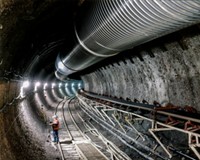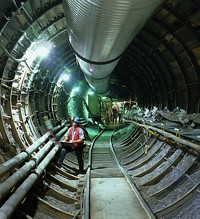Advertisement
Grab your lab coat. Let's get started
Welcome!
Welcome!
Create an account below to get 6 C&EN articles per month, receive newsletters and more - all free.
It seems this is your first time logging in online. Please enter the following information to continue.
As an ACS member you automatically get access to this site. All we need is few more details to create your reading experience.
Not you? Sign in with a different account.
Not you? Sign in with a different account.
ERROR 1
ERROR 1
ERROR 2
ERROR 2
ERROR 2
ERROR 2
ERROR 2
Password and Confirm password must match.
If you have an ACS member number, please enter it here so we can link this account to your membership. (optional)
ERROR 2
ACS values your privacy. By submitting your information, you are gaining access to C&EN and subscribing to our weekly newsletter. We use the information you provide to make your reading experience better, and we will never sell your data to third party members.
Nuclear Power
Radioactive waste stranded as U.S. shifts from nuclear energy
Lack of a long-term repository leaves communities as de facto storage sites
by Jeff Johnson, special to C&EN
August 28, 2018

The U.S. appears to be witnessing the slow death of nuclear power. Plants are aging out and retiring, and their place in the electricity marketplace is being captured by cheaper, simpler, and less controversial sources—particularly natural gas plants and renewable energy sources such as wind and solar.
But even as reactors shut down and communities eye former nuclear sites for redevelopment, a big problem remains: Despite more than 50 years of laws, regulations, lawsuits, and debates, the U.S. has no long-term repository for nuclear waste—nor even much of a plan for one.
A decade ago, more than 120 reactors generated electricity in the U.S., and the nuclear power industry and federal regulators were heralding a nuclear power renaissance. Today, however, operating reactors have dropped to 98. Twelve more reactors have committed to shutting down by 2024, according to Nuclear Regulatory Commission (NRC), which regulates nuclear power generators.
The rest of the current reactors will also likely close over the next two decades as they reach their expected lifetimes. Two power plants remain under some level of construction, half of the number planned a year ago.
As reactors shut down, radioactive spent fuel from decades of electricity production remains in pools and casks on the plant sites, much to the chagrin of nearby residents and civic leaders. They want the waste gone and the land put to productive use.
Al Hill is the mayor of Zion, Ill., a 25,000-resident community on the shore of Lake Michigan, 45 miles north of Chicago. In 1973, two reactors at Zion Nuclear Power Station began generating power for the region and operated until 1998. Since then, the plant has been successfully decommissioned, and by the end of this year, most concrete structures and the reactor cores will be hauled to low-level radioactive disposal sites, Hill says. However, 64 5-meter-tall, 150-metric-ton waste canisters will remain, lined up like giant bowling pins on a concrete slab 90 m from the lakeshore.
Back in 1968, when the community and the power plant owners, Exelon and Commonwealth Edison, first began discussions, the community felt that “nuclear power was a new technology capable of producing low-cost electricity, and the plant was good for Zion, good for Illinois, and good for the country,“ Hill says.
“People knew the community would give up 257 acres [104 hectares] of valuable lakefront land and lakeshore recreation and economic opportunities, and that the land would be an eyesore for a long, long time,” Hill says, speaking last month at an Environmental & Energy Study Institute symposium. “In exchange,” he continues, “Zion would benefit from jobs, an increase in its tax base, and, when the operating license expired, the 257 acres would be returned to pristine condition.
“That was the deal. It was unwritten, but it was the deal. There was never, ever an understanding that when the power plant closed, the city of Zion would play host to a nuclear waste dump containing 1 million kilograms of high-level radioactive spent nuclear fuel.”
Advertisement
Moreover, when the plant shut down, the community lost 800 jobs, the tax benefit from the plant dropped from $19 million annually to $1 million, and the stigma of the waste means that the city has struggled to find a developer willing to invest in the lakeshore site for commercial buildings or housing, Hill says.
Zion is not alone. Hill is part of a coalition of city and state officials who are or will soon be in similar straits as more reactors close. He estimates 80 other communities will be in the same boat.
“The situation at Zion is very typical,” says David McIntyre, an NRC spokesperson. “This is the political issue; this is the Yucca Mountain repository problem.”
It wasn’t supposed to be this way. Under the 1982 Nuclear Waste Policy Act, a U.S. geologic repository was to be operating by 1998. That act called for the creation of two waste repositories, one each in the eastern and western parts of the U.S. It also laid out a process to examine and select potential waste sites from several candidates. In 1987, however, Congress amended the law, modifying it in such a way that only Yucca Mountain in Nevada could qualify as a geological waste repository. The law was nicknamed the “screw Nevada bill.”
The state has opposed hosting a radioactive waste repository at Yucca Mountain from the start, notes geologist Allison Macfarlane, who served as NRC head from 2012–14 and before that was a member of a special blue-ribbon committee that examined the site-selection process. Some geologists, Native American tribes, and environmental organizations have also opposed a Yucca Mountain repository. Nevertheless, geologic site studies, pilot plant construction, and policy planning slowly advanced.
But while campaigning for president in Nevada in 2008, Barack Obama promised to cancel the site. When elected, he followed through and killed Yucca, then created the 15-member commission that included Macfarlane. The commission did not reconsider the geological suitability of Yucca Mountain as a waste repository. Rather, it spent two years examining the site selection process. It ultimately recommended a total overhaul of the site assessment and selection process, including having the process led by a “single-purpose federal corporation” instead of the Department of Energy. The commission also recommended a “consent-based” process with incentives offered to encourage communities and states to accept the waste.
Commission members pointedly said the Yucca Mountain approach had been a “top-down, federally mandated solution” that was forced onto a community and eventually would fail.
However, many Yucca Mountain advocates in Congress, particularly, Rep. John M. Shimkus (R-Ill.), challenged the Obama administration’s decision to cancel work on Yucca Mountain as a waste repository and introduced legislation to continue funding and development of the site. However, the legislation failed to clear Congress—and even if it had passed, Obama was likely to veto it.
Under President Donald J. Trump, things could be different. Shimkus has continued his push with a recent bill (H.R. 3053) by him and others to continue work on Yucca Mountain. That bill recently cleared the House of Representatives.
It is the furthest along of several bills introduced to address radioactive waste. Hill and other community leaders, for instance, support H.R. 3970. Introduced by Rep. Bradley Scott Schneider (D-Ill.), that bill calls for federal compensation for communities like Zion that appear to have become de facto long-term storage sites.
Any nuclear waste legislation, however, is unlikely to advance much until after the November elections.
“I don’t get the sense that nuclear waste is a high priority for the Trump administration,” former NRC head Macfarlane says. “There is no real group to put pressure to resolve the waste issue, except the people living near the shutdown sites. The nuclear industry is struggling right now, and they aren’t likely to pour money into this, and Congress appears willing to let it be.” Macfarlane still supports a consent-based approach for repository selection and would not comment on the suitability of Yucca Mountain as a repository
Meanwhile, NRC spokesperson McIntyre notes that two companies, Holtec International and Interim Storage Partners, are pursuing consolidated interim storage facilities and have applied for NRC licenses. The two sites are near one another in the southwest on both sides of the border between Texas and New Mexico.
Operations would be years away, McIntyre adds, and would require a complex—and also controversial—transportation plan to move the huge casks of radioactive material through much of the U.S.
Also, NRC is nearly ready to publicly release a proposed regulation to speed the decommissioning process. The regulation is needed, McIntyre says, because decommissioning is likely to become much more common and does not hold the same risks as an operating plant. Communities are watching closely for changes that might threaten safety, Hill says.
The regulation will have far-reaching impact, McIntyre notes, since the decommissioning process can legally take up to 60 years and will affect some 80 communities. But spent fuel removal will remain on hold, stored in casks or pools, until transportation and long-term repository issues are addressed.




Join the conversation
Contact the reporter
Submit a Letter to the Editor for publication
Engage with us on Twitter